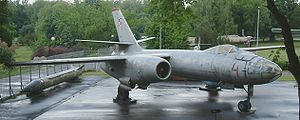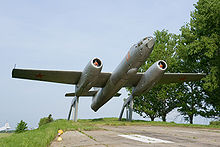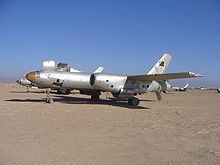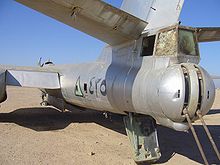Ilyushin Il-28 Video - Overview
|
|
Ilyushin Il-28
Il-28

Picture - Basic version of Il-28 in Polish Air Force colours
Role: Medium bomber
Manufacturer: Ilyushin
Avia (B-228 and CB-228)
Harbin Aircraft Manufacturing Corporation (H-5)
First flight: 8 July 1948
Introduction: 1950
Retired: 1980s (Soviet Union)
Primary users: Soviet Air Force
People's Liberation Army Air Force
Czechoslovak Air Force
Polish Air Force
Number built: over 6,731
Variants: Ilyushin Il-30
The Ilyushin Il-28 is a jet bomber aircraft of the immediate post war period that was originally manufactured for the Soviet Air Force. It was the USSR's first such aircraft to enter large-scale production. It was also licence-built in China as the Harbin H-5. Total production in the USSR was 6,316 aircraft, and over 319 H-5s were built. Only 187 examples of the HJ-5 training variant were manufactured. In the 1990s hundreds remained in service with various air forces over 40 years after the Il-28 first appeared.
The Il-28 has USAF/DoD reporting name "Type 27" and NATO reporting name 'Beagle', while the Il-28U trainer variant has USAF/DoD reporting name "Type 30" and NATO reporting name "Mascot".
Design and development
The aircraft is conventional in layout, with high, unswept wings carrying large engine nacelles beneath them. The bombardier is accommodated in the glazed nose, and the other end of the fuselage carries a turret with two 23 mm cannons. These features make it resemble the World War II medium bombers that preceded it, but the swept tail surfaces and the pilot's bubble canopy and ejector seat were more similar to other aircraft of its own era, making it a blend of old and new features.
Operational history

Picture - Ilyushin Il-28 monument at Tambov, Russia
The Il-28 was widely exported, serving in the air arms of some 20 nations ranging from the Warsaw Pact to various Middle-Eastern and African air forces. Egypt was an early customer, and targeting Egyptian Il-28s on the ground was a priority for the Israeli Air Force during the Suez Crisis, Six Day War, and Yom Kippur War. The Soviet Union was in the process of providing the type for local assembly in Cuba when this was halted by the Cuban Missile Crisis, after which Nikita Khrushchev agreed to remove them. The type also saw limited use in Vietnam and with the Afghan forces in Afghanistan. Four ex-Egyptian and two ex-Soviet Il-28s (all with Egyptian crews) were operated by the Nigerian Air Force in the Biafra Wars. Yemeni Il-28s took part in the civil war in that country. Finland also had four examples of this type delivered between 1961 and 1966 for target-towing duties. They remained in service until the 1980s.
The Soviet Union withdrew the type in the 1980s, while the last Soviet-built examples were still flying in Egypt into the 1990s. Chinese-built Il-28s designated H-5 and built by HAMC were also flying in the 1990s with several hundred in China itself, and a smaller number in North Korea and Romania. The three main Chinese versions are the H-5 bomber, followed by the HJ-5 trainer, and the H-5R (HZ-5) long range (in comparison to the reconnaissance version of Shenyang J-6) reconnaissance aircraft, and later, the HD-5 ECM/ESM version. The latter two types have been phased out.
The type is known to still be in active frontline service the North Korean Air Force in respectable numbers, although little is known as to whether they are a mix of survivors from the batch of 24 Soviet manufactured aircraft delivered in the 1960s and some of the newer Chinese built H-5 variant, or are solely H-5s.
First Il-28 in the West
On 11 November 1965, Li Xianbin (ææ¾æ), a PLAAF captain of an Ilyushin Il-28 of the 8th Bomber Division, Guangzhou Military Region, defected by flying his bomber numbered 0195 from Jianqiao (ç¬æ¡¥) air base in Hangzhou to Chiang Kai-shek International Airport, Taiwan and this was the first fully operational Il-28 in western hands. The radio operator / tail gunner Lian Baosheng (å»ä¿ç) was found dead at the scene and the navigator Li Caiwang (æææº) was captured alive after a failed suicide attempt. Both survivors were honored and rewarded positions in the Republic of China Air Force. Li Xianbin (ææ¾æ) was rewarded 2,000 taels (approximately 70 kg) of gold, while Li Caiwang (æææº) was rewarded 1,000 taels (approximately 35 kg) of gold. Since Lian Baosheng (å»ä¿ç) was dead, his reward of 1,000 taels (approximately 35 kg) of gold was divided evenly among Li Xianbin (ææ¾æ) and Li Caiwang (æææº).
Variants
Soviet Union variants
Il-28 - Three-seat bomber version
Il-28D - Long-range nuclear bomber for the Soviet Air Force
Il-28R - Three-seat tactical reconnaissance version
Il-28REB - Electronic warfare, electronic jamming version
Il-28RTR - Electronic reconnaissance version
Il-28S - Swept-wing version, scrapped before it was completed
Il-28T - Torpedo bomber version for the Soviet Naval Aviation able to accommodate one large or two small torpedoes in a lengthened weapons bay.
Il-28P - Civil conversion for Aeroflot mail service. By some accounts, also denoted Il-20
Il-28U - Training version
Il-28ZA - Atmospheric sampling version
Chinese variants
Harbin H-5 - (Hongzhaji - bomber) Chinese bomber version.
Harbin H-5A - Speculative designation of nuclear capable H-5 variant.
Harbin HD-5 - (Hongzhaji Dian - bomber/electronic reconnaissance) Chinese ECM/ESM version.
Harbin HJ-5 - (Hongzhaji Jiaolianji - bomber trainer)Chinese trainer version.
Harbin HZ-5 - (Hongzhaji Zhenchaji - bomber/reconnaissance) Long-range reconnaissance version.
Harbin B-5 - Export designation of the H-5
Harbin B-5R - Export version of HZ-5 long range photo reconnaissance version
Harbin BT-5 - Export version of the HJ-5.
Harbin H-5 Ying (Ying - eagle) Avionics testbed for Xian JH-7 programme.
Shenyang/CAE H-5B - Speculative designation for the H-5 re-engined with WS-5 aft-fan engines.
Operators

Picture - Il-28 operators
Afghanistan
Afghan Air Force
54 aircraft acquired (including four Il-28U examples) from 1957. Only trainers were retained beyond 1994. All grounded during the civil war in the 1990s. Albania
Albanian Air Force
Aviation Regiment 4020 operated one Il-28 acquired in 1957 attached to 2 Skuadrilja (2nd Squadron). This aircraft was traded for an H-5, the Chinese version of the Soviet Il-28, in 1971 and retired from service in 1992.. Algeria
Algerian Air Force

Picture - An Iraqi Il-28 bomber junked at Al Taqaddum, Iraq.
Bulgaria
Bulgarian Air Force
14 Il-28Rs and one Il-28U received in 1955 and retired in 1974. China
Hundreds of these aircraft were operated by the People's Liberation Army Air Force and People's Liberation Army Navy Air Force. Originally equipped with Soviet-built aircraft, the Chinese began full production of the H-5 by 1965. A small number may remain for use in secondary roles.
Cuba
Cuban Air Force
A total of 36 received in 1962, but soon returned to the Soviet Union as a result of the Cuban Missile Crisis. Czechoslovakia

Picture - Another Iraqi Il-28 bomber seen from the rear.
Czechoslovak Air Force
Soviet-built Il-28 and Il-28Us under the local designation B-228 and CB-228s operated from 1954 until 1973. 90 Il-28s, 30 Il-28RTs and an unknown number of Il-28Us were delivered. East Germany
East German Air Force
Operated 12 Il-28s and one Il-28U aircraft, primarily on target tug and engine testing duties between 1954 and 1982. Egypt
Egyptian Air Force
Received 70 Czechoslovakia-built Il-28s in 1956, shortly before the Suez Crisis. Some IL-28s still in service for limited use. Finland
Finnish Air Force
Received four aircraft in the 1960s, and used as target tugs until 1981. Hungary
Hungarian Air Force
3 Il-28s, 3 Il-28RTRs and 2 Il-28Us received from USSR and used between 1955 and 1967. Indonesia
Indonesian Air Force
21 Skadron based at Kemayoran Air Force Base, Jakarta received 12 Il-28s acquired in 1961. Aircraft were used during Operation Trikora in 1962 (the handover of Western New Guinea to Indonesia from the Netherlands). All of the aircraft were grounded in 1969 and retired in 1970. Iraq
Iraqi Air Force All destroyed or grounded after Desert Storm.
Nigeria
Nigerian Air Force
North Korea
North Korean Air Force
Operates an unknown number of IL-28 and H-5 aircraft. Pakistan
Pakistani Air Force
Operated a number of H-5s under the designation B-56. These aircraft served alongside American-built Martin B-57s. The H-5s were not popular with Pakistani pilots, and they were eventually traded back to China in exchange for more Shenyang F-6s. Poland
Polish Air Force
Received 72 Il-28s, 15 Il-28Rs and an unknown number of Il-28Us. The first aircraft arrived in 1952, last was retired in 1986.
7 PuÅk Lotnictwa Bombowo-Rozpoznawczego was based in Powidz.
21 PuÅk Rozpoznania Taktycznego operated Il-28R variant and was based in Sochaczew.
33 PuÅk Lotnictwa Bombowego was based in Modlin.
Romania
Romanian Air Force
About 22 Il-28s, three Il-28Rs and eight Il-28Us, both Soviet- and Chinese-built, operated from 1955. All remaining Il-28s were retired from service by June 2001. Somalia
Somali Air Corps
South Yemen
South Yemen Air Force
Soviet Union About 1,500 served with the Soviet Air Forces and the Soviet Navy (Soviet Naval Aviation), with operations beginning in 1950. Front line operations continued through the 1950s, with a few examples remaining into the 1980s. A small number of demilitarized aircraft were provided to Aeroflot. Syria
Syrian Air Force Replaced in 1980s by Su-24
Vietnam
Vietnam People's Air Force Retired.
Specifications (Il-28)
Data from
General characteristics
Crew: Three (pilot, bombardier, gunner)
Length: 17.60 m (57 ft 9 in)
Wingspan: 21.50 m (70 ft 6 in)
Height: 6.70 m (22 ft 0 in)
Wing area: 60.8 m² (654 ft²)
Empty weight: 11,890 kg (26,210 lb)
Loaded weight: 17,700 kg (39,000 lb)
Max takeoff weight: 21,200 kg (46,700 lb)
Powerplant: 2x Klimov VK-1 turbojets, 26.5 kN ()5,955 lbf each
Performance
Maximum speed: 900 km/h (486 kn, 560 mph)
Range: 2,180 km (1,177 nmi, 1,350 mi)
Service ceiling: 12,300 m (40,400 ft)
Rate of climb: 900 m/min (2,950 ft/min)
Wing loading: 291 kg/m² (59.6 lb/ft²)
Thrust/weight: 1:3.2
Armament
Guns: 4 x Nudelman NR-23 cannons (2 in nose and 2 in tail barbette)
Bombs: 3,000 kg (6,600 lb) of bombs in internal bay
Related development
Ilyushin Il-30
Ilyushin Il-46
Comparable aircraft
English Electric Canberra
Tupolev Tu-14
Il-28 at Greg Goebel's AIR VECTORS
EDISI KOLEKSI ANGKASA, RUDAL UDARA TRACKED AND DESTROYED, Edition of September 2006
Living Warbirds: The best warbirds DVD series.
Source: WikiPedia